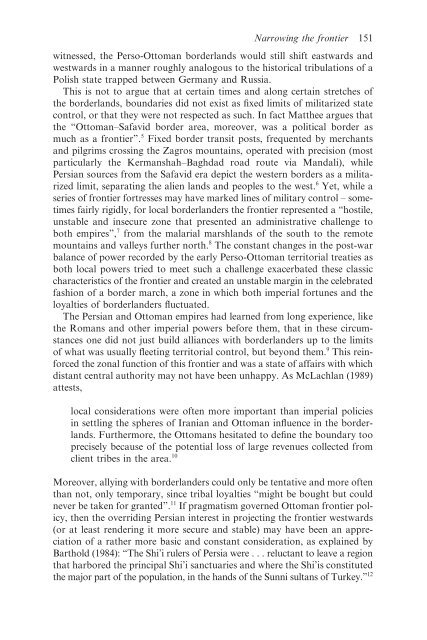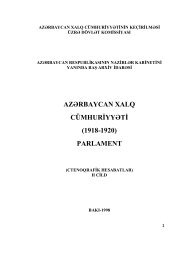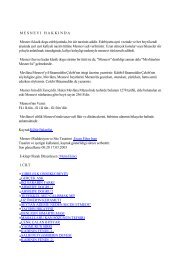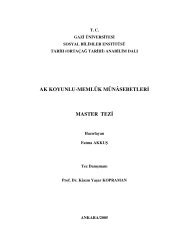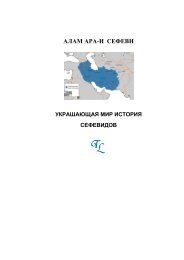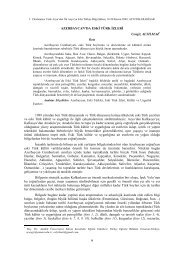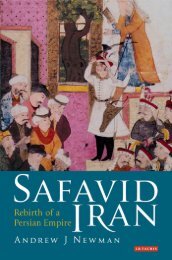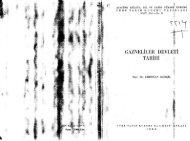War and Peace in Qajar Persia: Implications Past and ... - Oguzlar.az
War and Peace in Qajar Persia: Implications Past and ... - Oguzlar.az
War and Peace in Qajar Persia: Implications Past and ... - Oguzlar.az
- No tags were found...
Create successful ePaper yourself
Turn your PDF publications into a flip-book with our unique Google optimized e-Paper software.
Narrow<strong>in</strong>g the frontier 151witnessed, the Perso-Ottoman borderl<strong>and</strong>s would still shift eastwards <strong>and</strong>westwards <strong>in</strong> a manner roughly analogous to the historical tribulations of aPolish state trapped between Germany <strong>and</strong> Russia.This is not to argue that at certa<strong>in</strong> times <strong>and</strong> along certa<strong>in</strong> stretches ofthe borderl<strong>and</strong>s, boundaries did not exist as fixed limits of militarized statecontrol, or that they were not respected as such. In fact Matthee argues thatthe “Ottoman–Safavid border area, moreover, was a political border asmuch as a frontier”. 5 Fixed border transit posts, frequented by merchants<strong>and</strong> pilgrims cross<strong>in</strong>g the Zagros mounta<strong>in</strong>s, operated with precision (mostparticularly the Kermanshah–Baghdad road route via M<strong>and</strong>ali), while<strong>Persia</strong>n sources from the Safavid era depict the western borders as a militarizedlimit, separat<strong>in</strong>g the alien l<strong>and</strong>s <strong>and</strong> peoples to the west. 6 Yet, while aseries of frontier fortresses may have marked l<strong>in</strong>es of military control – sometimesfairly rigidly, for local borderl<strong>and</strong>ers the frontier represented a “hostile,unstable <strong>and</strong> <strong>in</strong>secure zone that presented an adm<strong>in</strong>istrative challenge toboth empires”, 7 from the malarial marshl<strong>and</strong>s of the south to the remotemounta<strong>in</strong>s <strong>and</strong> valleys further north. 8 The constant changes <strong>in</strong> the post-warbalance of power recorded by the early Perso-Ottoman territorial treaties asboth local powers tried to meet such a challenge exacerbated these classiccharacteristics of the frontier <strong>and</strong> created an unstable marg<strong>in</strong> <strong>in</strong> the celebratedfashion of a border march, a zone <strong>in</strong> which both imperial fortunes <strong>and</strong> theloyalties of borderl<strong>and</strong>ers fluctuated.The <strong>Persia</strong>n <strong>and</strong> Ottoman empires had learned from long experience, likethe Romans <strong>and</strong> other imperial powers before them, that <strong>in</strong> these circumstancesone did not just build alliances with borderl<strong>and</strong>ers up to the limitsof what was usually fleet<strong>in</strong>g territorial control, but beyond them. 9 This re<strong>in</strong>forcedthe zonal function of this frontier <strong>and</strong> was a state of affairs with whichdistant central authority may not have been unhappy. As McLachlan (1989)attests,local considerations were often more important than imperial policies<strong>in</strong> settl<strong>in</strong>g the spheres of Iranian <strong>and</strong> Ottoman <strong>in</strong>fluence <strong>in</strong> the borderl<strong>and</strong>s.Furthermore, the Ottomans hesitated to def<strong>in</strong>e the boundary tooprecisely because of the potential loss of large revenues collected fromclient tribes <strong>in</strong> the area. 10Moreover, ally<strong>in</strong>g with borderl<strong>and</strong>ers could only be tentative <strong>and</strong> more oftenthan not, only temporary, s<strong>in</strong>ce tribal loyalties “might be bought but couldnever be taken for granted”. 11 If pragmatism governed Ottoman frontier policy,then the overrid<strong>in</strong>g <strong>Persia</strong>n <strong>in</strong>terest <strong>in</strong> project<strong>in</strong>g the frontier westwards(or at least render<strong>in</strong>g it more secure <strong>and</strong> stable) may have been an appreciationof a rather more basic <strong>and</strong> constant consideration, as expla<strong>in</strong>ed byBarthold (1984): “The Shi’i rulers of <strong>Persia</strong> were . . . reluctant to leave a regionthat harbored the pr<strong>in</strong>cipal Shi’i sanctuaries <strong>and</strong> where the Shi’is constitutedthe major part of the population, <strong>in</strong> the h<strong>and</strong>s of the Sunni sultans of Turkey.” 12


